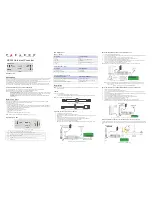
Parameters
(A) Application parameters
FR-F800
5 - 363
Calibration example
Adjust room temperature to 25 °C by PID control using a detector that outputs 4 mA at 0 °C and 20 mA
at 50 °C.)
When calibration is required
Calibrate detector output and set point input by Pr. 125, C2 (Pr. 902) to C4 (Pr. 903) (terminal 2) or
Pr. 126, C5 (Pr. 904) to C7 (Pr. 905) (terminal 4).
When both C42 (Pr. 934) and C44 (Pr. 935) are other than "9999", calibrate the detector output and
set point input by Pr. 934 and Pr. 935 (terminal 4).
(For the details, refer to page 5-260.)
Make calibration in the PU operation mode during an inverter stop.
For the PID gain tuning, refer to page 5-367.
I003043E
Fig. 5-173:
Calibration example
Set the room temperature to 25 °C
Set Pr. 128 and turn ON the X14 signal to enable PID control.
Start
Determination of set point
Conversion of set point into %
Determine the set point of what is
desired to be adjusted.
Calculate the ratio of the set point to
the detector output.
Detector specifications
When 0 °C
→
4 mA and 50 °C
→
20 mA are used, the set point 25 °C
is 50 % on the assumption that 4 mA is 0 % and 20 mA is 100 %.
Make calibration.
Make the following calibration
when the target setting input (0 to 5 V)
and detector output (4 to 20 mA) must be calibrated.
Setting of set point
Input a voltage across terminals 2–5
according to the set value %.
Operation
To stabilize the measured value,
change the proportional band (Pr. 129)
to a larger value, the integral time
(Pr. 130) to a slightly longer time, and
the differential time (Pr. 134) to a
slightly shorter time.
When performing operation, first set the
proportional band (Pr. 129) to a slightly larger
value, the integral time (Pr. 130) to a slightly
longer time, and the differential time (Pr. 134)
to "9999" (no function), and while looking at
the system operation, decrease the
proportional band (Pr. 129) and increase the
integral time (Pr. 130).
For slow response system where a deadband
exists, differential control (Pr. 134) should be
turned ON and increased slowly.
Is the set point stable?
Yes
No
Parameter adjustment
Parameter optimization
While the measured value is stable
throughout the operation status, the
proportional band (Pr. 129) may be
decreased, the integral time (Pr. 130)
decreased, and the differential time
(Pr. 134) may be increased.
Adjustment end
Set the proportional band (Pr. 129) to
a slightly larger value, the integral
time (Pr. 130) to a slightly longer time,
and the differential time (Pr. 134) to
"9999" (no function), and turn ON the
start signal.
To set the set point to 50 % using voltage input
The terminal 2 specification is 0 V for 0 %, and 5 V for 100 %.
Thus, to set to 50 %, input 2.5 V to the terminal 2.
To set the set point to 50 % using parameters
Set Pr. 133 = "50". (If C42 (Pr. 934) and C44 (Pr. 935)
≠
"9999", set
"25 (no % conversion)" directly in Pr. 133.)
Will you perform
PID gain tuning?
Yes
No
Operation
The optimal constants are
automatically set by PID gain
tuning.
The
proportional
band (Pr. 129),
integral time
(Pr. 130), and
differential time
(Pr. 134) are
automatically
set by PID gain
tuning.
Содержание FR-F800
Страница 2: ......
Страница 4: ......
Страница 28: ...Related manuals Introduction 1 8 ...
Страница 104: ...Connection of stand alone option units Installation and wiring 2 76 ...
Страница 162: ...Basic operation procedure JOG operation Basic operation 4 32 ...
Страница 720: ...Checking parameters changed from their initial values Initial value change list Parameters 5 558 ...
Страница 780: ...Measurement of main circuit voltages currents and powers Precautions for maintenance and inspection 7 20 ...
Страница 806: ...Outline dimension drawings Specifications 8 26 ...
Страница 833: ......
















































